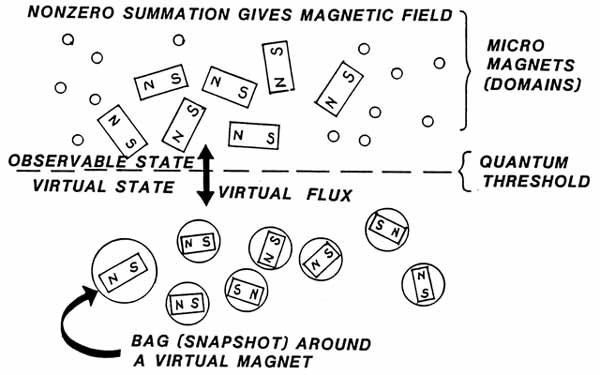Briefly,
let's look at some nice things we can do with magnetism.
Specifically, let's find out how to make magnetic monopoles and use them
to do things in the laboratory. This again has been done in a laboratory
on the North American continent.
First, about
all the present science can tell us about a magnet is that "a big
magnet is made of littler magnets." And if we examine one of
the smaller magnets, it's made of even smaller magnets. This is
like saying big dirt piles are made of smaller dirt piles, and that
explains what dirt is.
However,
let's use that with our knowledge of the virtual flux vacuum.
In this
slide, we show diagrammatically the situation for a common magnet.
Note that domains in the magnetic material are themselves little
magnets, and their alignment and vector summation determine whether or
not there's said to be a magnetic field present. Nonzero summation
states that there's a resultant magnetic vector, and hence an external
magnetic field. Zero summation states there's no external nonzero
resultant, hence no external magnetic field.
Actually, there's an external scalar magnetic potential field, even when
the external vector magnetic field is zero. The substructure is
still there.
If we
pursue this "big magnets are composed of smaller magnets,"
eventually we reach the quantum threshold, and we have a
substructure of virtual, subquantal magnets in vacuum, in the virtual
particle flux. At least we conceive each little virtual particle
as if it were spinning, and hence a little magnet.
We put
a conceptual bag around each little virtual magnet.
In a linear situation, the north pole is as strong as the south pole,
and so just outside the bag, the poles cancel or appear zero.
Since the virtual bag appears to be zero length to an external macro
observer, the poles seem to be directly superposed on top of each other,
yielding no pole at all to the observer.
However,
you and I now know that both poles are still in there, in the virtual
substructure, and we certainly have remaining with us a translated
scalar magnetic field.
There's a
virtual flux to and from each observable particle of charged mass in the
observable state as shown, but this flux is now scalar in virtual
magnets, except for nonlinearities in the structures above the quantum
level. Thus accelerated portions -- atoms with electrons in
whirling orbit, spinning electrons, protons, etc. -- possess nonzero
ordinary vector magnetic fields by translation. Again, notice the
successive interlocking levels of reality, all the way from deep in the
virtual state into interlocking levels in observable state.
Next Slide
|

